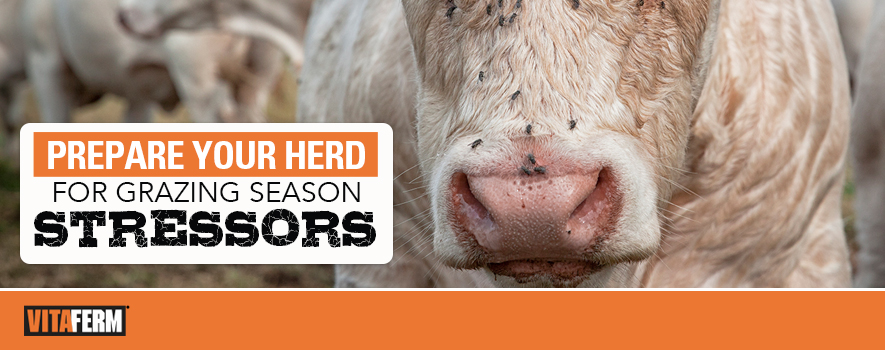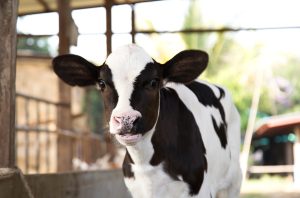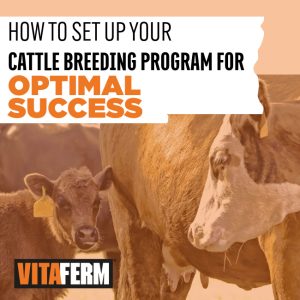
After a stressful winter across the country, cattle producers are surely looking forward to the sunshine and turning their cattle out to green pastures. Just as Mother Nature can cause havoc in the winter months, she can also add unnecessary stress to your herd in the spring and summer. However, with proper management, you can take a proactive approach to reducing and eliminating these summer stressors.
Heat
Perhaps the most obvious of summer challenges is heat. Although sunshine and warmer temps will be welcome after the bitter cold of winter, extreme high temperatures can negatively impact several production phases. Higher temperatures increase body temperature, and therefore lower conception and breed-back rates on spring-calving cows. Fall calves that are being weaned might be lower performing than normal due to increased body temperatures that typically lower intake and lead to reduced gains. And any cattle out grazing will more than likely be headed to shade or ponds, therefore decreasing the time they spend grazing and decreasing their dry matter intake.
Decreased Nutrient Levels
Although most of the country has had ample moisture and with a good warm-up and sunshine, pastures should be lush and full, the nutrient values of those pastures slowly diminish over time. At turnout, lush and immature forages are abundant and highly concentrated in key nutrients needed to sustain a cow that is providing for a rapidly growing calf while meeting her own needs to maintain and reproduce. However, forage quality changes on a daily basis. As a forage matures, nutrient quality decreases. Therefore, later in the grazing season forages may not be sufficiently meeting nutrient requirements for both herself and her growing calf. When forage quality and availability begin to decrease, nutrient intake drops, therefore lowering the average daily gain for your calves. Also, conception rates can be compromised if nutrient levels are not adequate.
Flies, Parasites
Flies and other external parasites are pests that add stress to cattle during the summer. Horn flies, horse flies and ticks are the biggest culprits around cattle. Horn fly females can lay up to 500 eggs, and their eggs typically hatch within 10-14 days, making the amount of the files that can move into a pasture a huge stress on the animals that are trying to get them off their backs and faces. Flies typically “feed” or suck blood 20-30 times per day, causing significant weight loss. Flies and ticks also spread Anaplasmosis, which can increase mortality rates and lower production outputs.
Grass Tetany
Finally, grass tetany is a challenge when first turning out pairs to lush pastures. Most producers think of tetany as a magnesium deficiency, because many use magnesium to prevent occurrence, but really it is excessive intake of potassium. Potassium and magnesium compete for the same absorption pathway. Think of it like a funnel where three potassium marbles are trying to get through the funnel at the same time as one magnesium marble. Since the percentage of potassium marbles is greater, that nutrient is more likely to go down the funnel and get absorbed before the magnesium does. Tetany typically occurs in older animals rather than younger animals because of an inability to mobilize the magnesium from the bones. Mature cows will show signs long before a young calf.
Prevention of Stressors
Since the warmer temperatures, sunshine and lush green pastures are much anticipated, it is inevitable that the heat, flies and other stressors associated with spring and summer will be present. However, with some proactive steps, you can help keep the stress on your herd reduced.
The most important step you can take to ensure your cattle are comfortable during the heat is to provide them with plenty of clean, fresh water. Water is the most vital nutrient to survival and during the summer, it becomes even more critical. Be sure to have a free-flowing constant source of water or be available to check water levels regularly to make sure cattle have fresh water and the tanks are at a level where even young calves can reach their necks in to drink.
You’ll also want to provide adequate shade for your cattle. This might be a tree grove, a wooden wind break that “doubles” as shade, an open-sided or open-fronted building that also has adequate air flow or another man-made structure. Whatever the shade source, make sure it is big enough for the amount of cattle in the pen, and that there is adequate air flow in or around it, especially if it is a building.
In the summer months, you will want to reduce the amount of handling you do with your cattle. If you must do any work, be sure to work them in the early morning or in the evening, avoiding the hottest times of the day. And, have all your necessary supplies ready, gates set and practice proper handling techniques to reduce the amount of time you have to work the animals and the amount of stress you put on them.
For fly control there are a variety of external methods that producers might try like insecticide sprays, back rubbing devices, dust bags and insecticide-based ear tags. Parasites can be controlled through deworming at least once a year. Work with your local veterinarian to determine the best protocol for pests in your specific area.
Perhaps the best step you can take to help combat these stressors on your herd is to feed a high-quality mineral program from VitaFerm® with the Amaferm® advantage. Amaferm®️ is a prebiotic designed to enhance digestibility by amplifying the nutrient supply for maximum performance. It is research-proven to increase intake, digestion and absorption.
Therefore, the cattle on a VitaFerm mineral with Amaferm will get the most good from the nutrients they do consume even with the nutrient content begins to diminish.
VitaFerm HEAT® specifically targets heat stress by aiding in improving internal thermoregulation through improved circulation and intake modification. In other words, better circulation helps cattle to more efficiently cool themselves and consuming smaller meals more frequently throughout the day not only increases DMI, but also alleviates some of heat generated by the rumen during digestion. HEAT includes capsaicin, research-proven to lower body temperature, which can improve conception rates by maintaining pregnancy, and garlic, to deter insects – both important to summer time stress.
“We really see a difference in fly control with our cows. When it is really hot out, we see fewer cows pond up, and they are out grazing more frequently. Perhaps the biggest impact is the difference we see here where we graze on fescue. We have lost fewer pregnancies from fescue toxicity since we started feeding the HEAT mineral,” said Charlie Boyd II, Angus and Hereford breeder from Mays Lick, Ky.
Boyd also feeds a high-magnesium mineral, VitaFerm® Concept•Aid® Mag 5/S, He said he is susceptible to grass tetany, yet has had no problems with it since he’s started on a higher-mag mineral.
The sunshine and lush green grass will be very welcome to cattle producers after the winter of 2019; but with heat comes more stress. Eliminate some of that stress with VitaFerm products with the Amaferm advantage and positively impact your operation.


